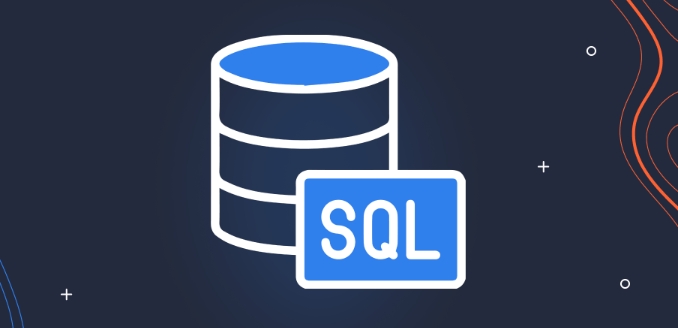Reference Data Management with SQL
Reasons for using SQL in reference data management include clear structure, consistency guarantee, ease of maintenance and convenient permission control. The design reference data table should contain fixed fields such as ID, code, description and enable status, add metadata information, adopt reasonable naming specifications, and use enable/disable mechanisms instead of deletion. Maintenance and update reference data should adopt versioned updates, script management changes, combined with audit procedures, and avoid manual direct connection to the production environment. To ensure cross-system consistency, it can be achieved through mechanisms such as ETL tool synchronization, unified API services, or materialized views.

Application of SQL in reference data management

Reference data are the basic data used to classify, standardize and unify business information, such as status codes, country lists, product types, etc. Although these data may seem simple, poorly managed can lead to system chaos and even wrong decisions. Using SQL to manage reference data is not only efficient and controllable, but also seamlessly integrated with existing database systems.
Why choose to use SQL to manage reference data?
The master data of many systems exists in relational databases, and SQL happens to be the standard language for operating this type of data. There are several obvious advantages to using SQL to manage reference data:

- Clear structure : Through the definition of table structure, the meaning and purpose of each reference value can be clarified.
- Consistency guarantee : Through foreign key constraints, ensure that the data referenced by other tables is legal.
- Easy to maintain : Add, delete, modify and check can be done through simple SQL statements, which are suitable for regular updates.
- Convenient permission control : You can set access permissions based on user roles to avoid misoperation.
For example, an "Order Status" reference table may contain status_code and description fields. Other order tables are associated with this table through foreign keys, so that the status values are always consistent.
How to design a reference data table?
There are several key points to be paid attention to when designing to ensure that it is easy to use and not prone to errors in the future:

- Fixed field structure : usually includes basic fields such as ID (primary key), code, description, and enabled status (active_flag).
- Adding metadata information : such as creation time, modification time, creator, etc., will help to post-audit and track changes.
- Reasonable naming specification : It is recommended to start with
_reforlookup_, such asstatus_ref, you can tell it is a reference table at a glance. - Enable/disable mechanism instead of deletion : Deleting records may cause historical data to be invalid, so it is better to add an
is_activefield for soft deletion.
For example, if you have a "payment method" reference table, you can create the table like this:
CREATE TABLE payment_method_ref (
method_id INT PRIMARY KEY,
method_code VARCHAR(20) NOT NULL UNIQUE,
description VARCHAR(100),
is_active BOOLEAN DEFAULT TRUE,
created_at TIMESTAMP DEFAULT CURRENT_TIMESTAMP
);How to maintain and update reference data?
The reference data is not static and needs to be updated or adjusted regularly. It is recommended to follow the following practices during maintenance:
- Versioned update : If the meaning of a certain code changes significantly, you can consider keeping the old record and adding a new one instead of directly modifying it.
- Use scripts to manage changes : Write insert and update statements into SQL scripts for easy version control and automated deployment.
- In combination with the audit process : there should be an approval mechanism for modifications to important reference data, which can be implemented through triggers or additional log tables.
- Avoid manual direct connection to production environments : SQL can be tested locally during the development or testing phase, and will be reviewed and executed through DBA before going online.
Common maintenance operations include:
- Insert new value:
INSERT INTO ... - Deactivate old values:
UPDATE SET is_active = FALSE WHERE ... - Query available values:
SELECT * FROM ... WHERE is_active = TRUE
Data synchronization and cross-system consistency
If multiple systems share the same set of reference data, special attention should be paid to maintaining consistency. Common practices are:
- Use the ETL tool to synchronize the reference table regularly.
- In the microservice architecture, a unified reference data API service can be provided.
- If the database supports it, you can use materialized views or replicate table mechanisms to keep multiple libraries consistent.
Although there are many technical details in this part of the work, the key is to establish a set of standard processes and continuously monitor data differences.
Basically that's it. As a basic tool, although SQL is not good at managing reference data, it is highly practical. As long as it is designed properly, it is not complicated to maintain.
The above is the detailed content of Reference Data Management with SQL. For more information, please follow other related articles on the PHP Chinese website!

Hot AI Tools

Undress AI Tool
Undress images for free

Undresser.AI Undress
AI-powered app for creating realistic nude photos

AI Clothes Remover
Online AI tool for removing clothes from photos.

Clothoff.io
AI clothes remover

Video Face Swap
Swap faces in any video effortlessly with our completely free AI face swap tool!

Hot Article

Hot Tools

Notepad++7.3.1
Easy-to-use and free code editor

SublimeText3 Chinese version
Chinese version, very easy to use

Zend Studio 13.0.1
Powerful PHP integrated development environment

Dreamweaver CS6
Visual web development tools

SublimeText3 Mac version
God-level code editing software (SublimeText3)
 How do you calculate the difference between two dates in SQL?
Aug 02, 2025 pm 01:29 PM
How do you calculate the difference between two dates in SQL?
Aug 02, 2025 pm 01:29 PM
To calculate the difference between two dates, you need to select the corresponding function according to the database type: 1. Use DATEDIFF() to calculate the day difference in MySQL, or specify the units such as HOUR and MINUTE in TIMESTAMPDIFF(); 2. Use DATEDIFF(date_part, start_date, end_date) in SQLServer and specify the units; 3. Use direct subtraction in PostgreSQL to obtain the day difference, or use EXTRACT(DAYFROMAGE(...)) to obtain more accurate intervals; 4. Use julianday() function to subtract the day difference in SQLite; always pay attention to the date order
 What are the BLOB and CLOB data types in SQL?
Aug 07, 2025 pm 04:22 PM
What are the BLOB and CLOB data types in SQL?
Aug 07, 2025 pm 04:22 PM
BLOBstoresbinarydatalikeimages,audio,orPDFsasrawbyteswithoutcharacterencoding,whileCLOBstoreslargetextsuchasarticlesorJSONusingcharacterencodinglikeUTF-8andsupportsstringoperations;2.Bothcanhandleuptogigabytesofdatadependingonthedatabase,butperforman
 Optimizing SQL ORDER BY for Query Performance
Aug 04, 2025 am 11:19 AM
Optimizing SQL ORDER BY for Query Performance
Aug 04, 2025 am 11:19 AM
To optimize the performance of ORDERBY in SQL, you must first understand its execution mechanism and make rational use of index and query structure. When the sorting field has no index, the database will trigger "filesort", consuming a lot of resources; therefore, direct sorting of large tables should be avoided and the amount of sorted data should be reduced through WHERE conditions. Secondly, establishing a matching index for sorting fields can greatly speed up queries, such as creating reverse order indexes in MySQL 8.0 to improve efficiency. In addition, deep paging (such as LIMIT1000, 10) should be used instead with index-based cursor paging (such as WHEREid>12345) to skip invalid scans. Finally, combining caching, asynchronous aggregation and other means can also further optimize the sorting performance in large data set scenarios.
 How do you grant and revoke permissions in SQL?
Aug 04, 2025 am 09:19 AM
How do you grant and revoke permissions in SQL?
Aug 04, 2025 am 09:19 AM
GRANTandREVOKEstatementsareusedtomanageuserpermissionsinSQL.1.GRANTprovidesprivilegeslikeSELECT,INSERT,UPDATE,DELETE,ALTER,EXECUTE,orALLPRIVILEGESondatabaseobjectstousersorroles.2.SyntaxforgrantingisGRANTprivilege_typeONobject_nameTOuser_or_role,allo
 How does the EXISTS operator compare to the IN operator in SQL?
Aug 05, 2025 pm 01:08 PM
How does the EXISTS operator compare to the IN operator in SQL?
Aug 05, 2025 pm 01:08 PM
UseEXISTSforexistencechecks,especiallywithlargeorcorrelatedsubqueriesandwhenNULLvaluesarepresent,asitstopsatthefirstmatchandhandlesNULLssafely;useINformembershipchecksagainstsmall,known,ornon-nullvaluesetswherereadabilitymattersandperformanceisnotcri
 How to get the first and last day of the year in SQL?
Aug 11, 2025 pm 05:42 PM
How to get the first and last day of the year in SQL?
Aug 11, 2025 pm 05:42 PM
ThefirstdayoftheyearisobtainedbyconstructingortruncatingtoJanuary1stofthegivenyear,andthelastdayisDecember31stofthesameyear,withmethodsvaryingbydatabasesystem;2.Fordynamiccurrentyeardates,MySQLusesDATE_FORMATorMAKEDATE,PostgreSQLusesDATE_TRUNCorDATE_
 How to find the sum of a column in SQL?
Aug 08, 2025 pm 05:54 PM
How to find the sum of a column in SQL?
Aug 08, 2025 pm 05:54 PM
TofindthesumofacolumninSQL,usetheSUM()function,whichreturnsthetotalofallnumericvaluesinaspecifiedcolumnwhileignoringNULLs;1.Usebasicsyntax:SELECTSUM(column_name)ASaliasFROMtable_name;2.Ensurethecolumnhasnumericdatatoavoiderrors;3.ApplyWHEREtofilterro
 Understanding SQL Execution Context and Permissions
Aug 16, 2025 am 08:57 AM
Understanding SQL Execution Context and Permissions
Aug 16, 2025 am 08:57 AM
SQL execution context refers to the identity or role when running SQL statements, which determine which resources and operation permissions can be accessed. Permission setting should follow the principle of minimum permissions, and common permissions include SELECT, INSERT, EXECUTE, etc. To troubleshoot permission issues, you need to confirm the login name, role permissions, EXECUTEAS settings and schema authorization. Performing context switching can be implemented through EXECUTEAS, but attention should be paid to user existence, permission granting and performance security impact. It is recommended to avoid arbitrarily assigning db_owner or sysadmin roles. The application account should only access necessary objects and be authorized through schema.







